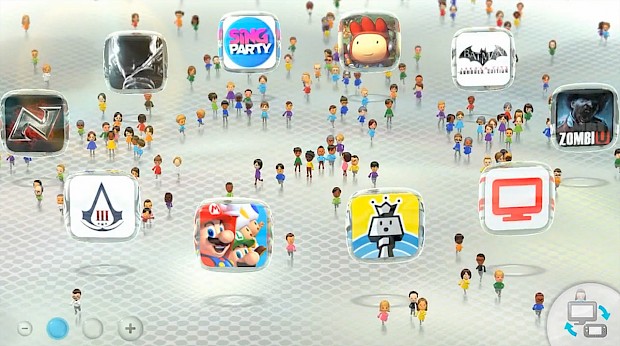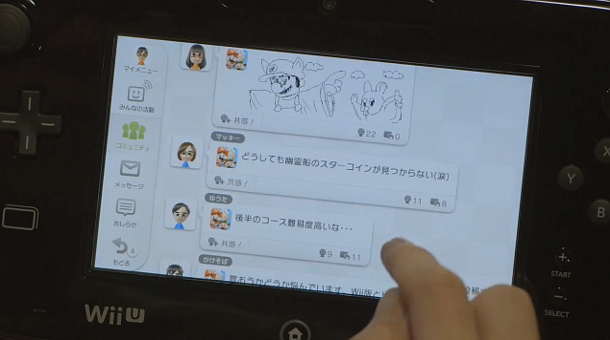Is being sociable the 'new' game?

Posted 18 Nov 2012 at 11:10 by Mark Lee
I can't help but be impressed by the Wii U’s features that have been drip-fed to gamers the world over during the last few months. Not only are the social aspects of the system impressive, but the way in which Nintendo are embracing their audience via the web continues to grow from strength-to-strength.
The way in which Nintendo’s online content is inextricably linked to their current and future platforms is becoming increasingly apparent. The 3DS has enabled Nintendo (and other developers) to directly contact system owners with messages and, via the eShop, Nintendo news is now available for consumption 24/7 directly from the company itself.
What we currently have is a more connected Nintendo, a more online-focused Nintendo reaching out to fans with ever-growing frequency. Of course, such immersion has caused minor concern amongst some gamers. When the Nintendo 3DS launched numerous articles noted that the console’s Terms of Service stipulated that Nintendo can track your system usage and actually own some of your content. Some even continue to send Nintendo bricks in protest.
Yet, until the reveal of the Wii U Nintendo had, for the most part, avoided the full online experience that the modern user expects as an option. Instead, Nintendo tested the waters of the online world through certain software and the Wii’s channel interface. With the advent of the Wii U, what is becoming apparent is that Nintendo appear to have now settled on a solution that is congruent with the house of Mario, through the use of their Mii characters, resulting in the Wii U being built around an embedded social networking ecosystem.

Nintendo 'tested' the impact of the web and social media during the development of Smash Bros. Brawl. N-Europe analysed the impact of this back in 2008.
Of course, communicating between fellow gamers is nothing new to core players that have been gaming for years. Yet it is perhaps the casual and younger audiences that will be interesting to watch in this new social space. Since the 1980s, core gamers have always wanted to share their experiences through gaming portals, magazines and 'club' periodicals. This allowed passionate gamers to communicate with fellow players via feedback, tips and informative letters. With the arrival of the Internet this community boomed. Suddenly, forums and self-made media grew and, as stated by George Harrison, even Nintendo were surprised in 2006 when the Wii went viral at launch and beyond.
Nintendo now have first-hand experience on the value of the social (and financial) impact of the web. When you see Nintendo playfully throwing in nondescript action figures and staring at fruit in their videos, you can see that they are embracing the social side of the web like never before, while seemingly having fun along the way. Here is a confident company, communicating with its fans in an informed, direct and, most importantly, humorous way.
So when the Wii U launches with a built-in portal for gamer discussion and easily-accessible web-browser functionality, I can't help but think Nintendo is smarter than we all give it credit for. With the Wii U we may possibly experience something similar to the smartphone revolution, where integration between the web and device creates a personalised, empathic user environment (Satoru Iwata even dubbed the Nintendo network an “empathy network”). The mobility of the GamePad, as well as future smart phone and PC integration, backs up this premise; allowing gamers to check notifications and connect with ease - as and when it suits them. This is Nintendo stepping out into a brave new world, this is a new Nintendo in full swing.

Will checking Miiverse be as addictive as checking other social feeds?
Just as other social tools have enabled us to connect with past school friends, work colleagues, celebrities, distant family members, friends and acquaintances, the Wii U is aiming to do the same for the world of gaming. That kind of interaction, as experienced today through gaming sites and forums, creates friendships, clans, competition and emotional highs and lows – all of which are key elements in games. You just need to look at Criterion’s Need for Speed: Most Wanted to see how social interaction can increase a games longevity and scope. It is easy to see the alluring possibilities here.
Finally, as I type this article on a tablet, my phone sits beside me and my TV is playing in the distance. As Satoru Iwata explored when referencing Sherry Turkle's book 'Alone Together', we now truly live in a multi-screened world where our social boundaries cross our digital ones (as a side-note I highly recommend Turkle's book, it is a fascinating read).
So here comes the new Nintendo way to play. True next-gen looks to be about having options: connect or disconnect as you see fit, game on the television or in the palm of your hand, play alone or play together, anytime you want.
But the bigger picture remains, as Nintendo continue on their path to widen perceptions of the industry. Gone will be the days of the lone gamer in their basement. Active, family-friendly gaming made great strides thanks to the Wii and with Wii U it seems, for now, that Nintendo are continuing to shake the foundations of those misconceptions all over again. Will social media be the answer to this?
As with all things Nintendo, only time will tell.






















